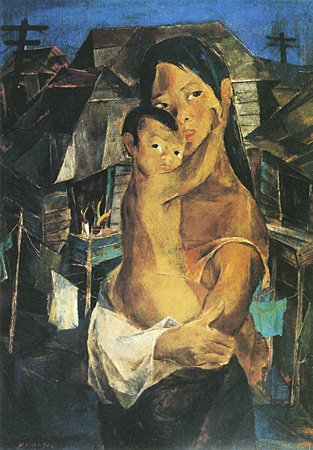Cultural Center of the Philippines
ENCYCLOPEDIA OF
PHILIPPINE ART
Madonna of the Slums
1950 / Oil on masonite / 86.5 x 61 cm / Artist: Vicente Manansala
The subject of the urban poor in the setting of slums appeared in postwar paintings, manifesting the trend in “proletarian art.” In this work, which captures the anxious and insecure mood of the period, the artist used predominantly brown tones to bring out the makeshift character of the houses, the patchwork roofs of surplus material, the grime, the crowding, and the hunger. The cubist geometricizing style lends itself successfully to the subject. Structured into planes and facets, the madonna and child figure acquires an essential simplicity and austere purity. The central figure conveys a presence that consists of the combination of vulnerability in the lack of social embellishments, and dignity and solidity in the broadly structured lines.
The artist renounces single-point perspective in favor of multiple perspective, particularly in the houses where the planes of the roofs and walls meet at varying angles, the better to convey the sense of crowding. Unlike in the style of analytical cubism, he does not fragment and dissect the human figure, leaving stray clues of its identity. Instead he stays close to the figure, which he simplifies into its basic geometric structure. For Manansala, cubism was not a fragmenting or dehumanizing principle but a structuring one. The artist also brings out the humanism of the subject in the expressive faces—the mother with a keen and wary look, and the child reaching up to his mother’s face in a protective gesture against the cruelty and injustice of the world. Madonna of the Slums is a key modernist painting of the 1950s.
Written by Alice G. Guillermo
